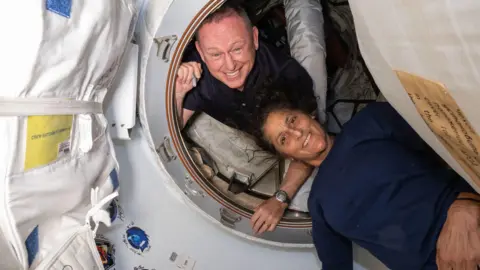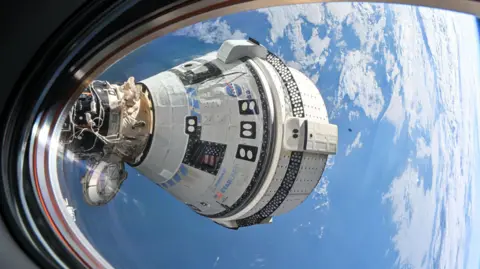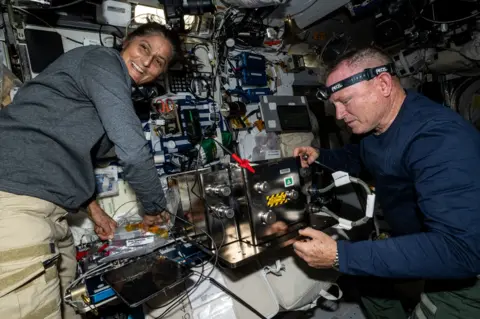The Boeing Starliner spacecraft returns to Earth

 NASA
NASABoeing’s Starliner spacecraft has completed its journey back to Earth – but the astronauts it was supposed to carry are still stuck at the International Space Station.
The empty boat was traveling in autonomous mode after retreating from the orbiting workshop.
The capsule, which encountered technical problems after it was launched with Nasa’s Butch Wilmore and Suni Williams on board, was deemed too dangerous to take the astronauts home.
Instead they will return with the SpaceX Crew Dragon, but only until February – extending the eight-day stay on the ISS to eight months.
The Starliner’s return flight took six hours. After it re-entered Earth’s atmosphere, parachutes were used to slow its descent at White Sands Space Harbor in New Mexico on Saturday.
Nasa said that previously Butch and Suni were in good spirits and were in regular contact with their families.
Steve Stich, Nasa commercial crew program manager, told a press conference that both astronauts love their jobs.
“They understand the importance now of continuing to return the car safely.”
This was the first manned test flight of Boeing’s Starliner spacecraft.
But it was plagued by problems shortly after it blasted off from Cape Canaveral in Florida on June 5.
The capsule developed a helium leak, pushing fuel into the propulsion system, and several of its thrusters malfunctioned.
Engineers at Boeing and Nasa spent months trying to understand these technical problems, but in late August the US space agency decided that the Starliner was not safe enough to bring astronauts home.
Steve Stich admitted that there was “disagreement in the room” between Boeing and NASA when the decision was made, with Boeing arguing that their spacecraft could return safely with the two on board.
“The NASA team, due to uncertainty and modeling, could not be comfortable with that,” he said.
The launch program by rival company SpaceX has brought significant delays to the return of astronauts.
The extra time is to allow SpaceX to launch its next vehicle, with liftoff scheduled for late September.
There were supposed to be four astronauts on the ship, but instead it will go with two. This leaves room for Butch and Suni to join them on the vehicle that will return to Earth at the end of its scheduled stay next February.
 NASA
NASADana Weigel, manager of the International Space Station, said the astronauts are adapting well to their extended mission. Both have previously completed long-term spacewalks.
He said that they are doing the necessary exercise programs to stay healthy in a weightless environment.
He also added that they now have all the gear they need to stay for eight months unplanned.
“When we first sent them, they were borrowing a lot of our standard equipment that we have, and now we have changed some of those things,” he said.
He explained that the resupply operation in July had brought “certain things that the workers liked” that they had requested.
“So they’ve got all the normal gear for the trip right now and they’re going to be able to choose another team member. And we have another freighter coming, so we’ll send anything else they’ll need for the back end of their mission on that plane. “
 NASA
NASAThe problems with the Starliner have no doubt caught the eye of Boeing, which is struggling to make money as it struggles to repair its reputation following recent plane crashes and two fatal crashes in the past five years.
After so many problems, a smooth landing would be the most desirable outcome for the company – and for Nasa.
“After we get the car back, we’ll process it a few months after the flight,” said Steve Stich.
“There are groups that are starting to look at what we can do so that the car can be fully guaranteed in the future.”
The US space agency has reiterated its commitment to Boeing’s space program – having two American companies take astronauts into space has been a key goal for Nasa for a long time.
When their space shuttle was retired in 2011, the US spent a decade relying solely on the Russian Soyuz spacecraft to transport its crew and cargo – a situation that Nasa admitted was not ideal.
So in 2014, Boeing and SpaceX were awarded contracts to supply space planes for Nasa astronauts – Boeing was worth $4.2bn (£3.2bn) while SpaceX got $2.6bn (£2bn).
So far SpaceX has sent nine crewed flights into space for NASA, as well as some commercial missions, but this was Boeing’s first attempt at a crewed mission.
Boeing’s Starliner had already been delayed for several years due to problems in the development of the spacecraft and the two previous flights that were not operational in 2019 and 2022 also had technical problems.
But NASA administrator Bill Nelson says he is confident it will fly with the team again.
Source link




